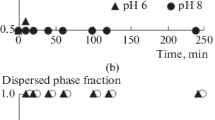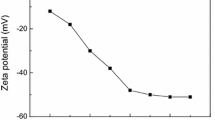Abstract
Silica nanoparticles were functionalized with amine and quaternary ammonium groups using a two-step chemical surface modification, to allow coating with anionic polymers for emulsion stabilization. This strategy proved to render high colloidal stability in aqueous dispersions and strong electrostatic interactions with polyacrylic acid and poly(sodium 4-styrene sulfonate), over a wide pH range. These hybrid nanoparticles stabilized Pickering emulsions at very low concentrations (0.01 wt%), without added surfactants. Most stable emulsions were obtained with nanoparticles coated with polyacrylic acid, due to synergy of strong interfacial adsorption of nanoparticles enhanced by the long polymeric chains and the weak polyelectrolyte character of the polymer. These nanoparticles were able to prevent diffusion of N,N′-diethyl-m-toluamide (DEET), a common insect repellent, from oil-in-water emulsions into a model media. The release profile followed typical zero-order kinetics, demonstrating the potential of using the polymer-coated nanoparticles developed in this work in DEET formulations to achieve extended repellent action.

Graphical abstract






Similar content being viewed by others
References
Qiu H, Jun HW, Dzimianski M, McCall JW (1997) Reduced transdermal absorption of N, N-diethyl-m-toluamide from a new topical insect repellent formulation. Pharm Dev Technol 2:33–42. https://doi.org/10.3109/10837459709022607
Stanczyk NM, Brookfield JF, Ignell R, Logan JG, Field LM (2010) Behavioral insensitivity to DEET in Aedes aegypti is a genetically determined trait residing in changes in sensillum function. Proc Natl Acad Sci 107(19):8575–8580. https://doi.org/10.1073/pnas.1001313107
Islam J, Zaman K, Duarah S, Raju PS, Chattopadhyay P (2017) Mosquito repellents: an insight into the chronological perspectives and novel discoveries. Acta Trop 167:216–230. https://doi.org/10.1016/j.actatropica.2016.12.031
Milutinović R, Vuleta G, Milić J, Stajković N (1999) Assessment of efficiency of repellent formulations with N,N-diethyl-m-toluamide in laboratory conditions. Int J Cosmet Sci 21:7–14. https://doi.org/10.1046/j.1467-2494.1999.181696.x
Santos EP, Carmo FA, Pinto IC, Cerqueira-Coutinho CS, Ricci-Junior E (2017) Development and characterization of repellent formulations based on nanostructured hydrogels. Drug Dev Ind Pharm 43(1):67–73. https://doi.org/10.1080/03639045.2016.1220564
Misni N, Nor ZM, Ahmad R (2017) Repellent effect of microencapsulated essential oil in lotion formulation against mosquito bites. J Vector Borne Dis 54:44–53 https://www.ncbi.nlm.nih.gov/pubmed/28352045
Reifenrath WG (2012) Mechanisms of percutaneous absorption of pesticide formulations. In: Knaak JB, Timchalk C, Tornero-Velez R (eds) Parameters for pesticide QSAR and PBPK/PD models for human risk assessment, ACS Symposium Series, pp 87–111 https://doi.org/10.1021/bk-2012-1099.ch007
Sibaja AMA, Fandaruff C, Delgado MTL (2013) N,N-diethyl-meta-toluamide (DEET) in repellent solutions: development and validation of an analytical method. Braz J Pharm Sci 3:273–278 http://www.rbfarma.org.br/files/rbf-v94n3-11.pdf
Tavares M, da Silva MRM, de Oliveira de Siqueira LB, Rodrigues RAS, Bodjolle-d’Almeida L, Dos Santos EP, Ricci-Junior E (2018) Trends in insect repellent formulations: a review. Int J Pharm 539(1–2):190–209. https://doi.org/10.1016/j.ijpharm.2018.01.046
Domb AJ, Marlinsky A, Maniar M, Teomim L (1995) Insect repellent formulations of N,N-diethyl-m-toluamide (DEET) in a liposphere system: efficacy and skin uptake. J Am Mosq Control Assoc 11:29–34 https://www.ncbi.nlm.nih.gov/pubmed/7616186
Mansur CRE, Ricci-Júnior E, Lopes LMA, Barradas TN, de Holanda SKG (2013) Development and characterization of micellar systems for application as insect repellents. Int J Pharm 454(2):633–640. https://doi.org/10.1016/j.ijpharm.2013.05.050
Binks BP, Fletcher PD, Holt BL, Beaussoubre P, Wong K (2010) Selective retardation of perfume oil evaporation from oil-in-water emulsions stabilized by either surfactant or nanoparticles. Langmuir 26(23):18024–18030. https://doi.org/10.1021/la103700g
Horikoshi S, Akao Y, Ogura T, Sakai H, Abe M, Serpone N (2010) On the stability of surfactant-free water-in-oil emulsions and synthesis of hollow SiO2 nanospheres. Colloids Surf A Physicochem Eng Asp 372(1–3):55–60. https://doi.org/10.1016/j.colsurfa.2010.09.036
Tang J, Quinlan PJ, Tam KC (2015) Stimuli-responsive Pickering emulsions: recent advances and potential applications. Soft Matter 11(18):3512–3529. https://doi.org/10.1039/c5sm00247h
Zhang Y, Guo S, Wu W, Qin Z, Liu X (2016) CO2-triggered Pickering emulsion based on silica nanoparticles and tertiary amine with long hydrophobic tails. Langmuir 32(45):11861–11867. https://doi.org/10.1021/acs.langmuir.6b03034
Tshilumbu NN, Masalova I (2015) Stabilization of highly concentrated emulsions with oversaturated dispersed phase: effect of surfactant/particle ratio. Chem Eng Res Des 102:216–233. https://doi.org/10.1016/j.cherd.2015.06.025
Aveyard R, Binks BP, Clint JH (2003) Emulsions stabilised solely by colloidal particles. Adv Colloid Interf Sci 100-102:503–546. https://doi.org/10.1016/s0001-8686(02)00069-6
Organization WH (2009) Guidelines for efficacy testing of mosquito repellents for human skin. Switzerland, Geneva https://apps.who.int/iris/handle/10665/70072
Pickering SU (1907) Emulsions. J Chem Soc Trans 91(0):2001–2021. https://doi.org/10.1039/ct9079102001
Saigal T, Dong H, Matyjaszewski K, Tilton RD (2010) Pickering emulsions stabilized by nanoparticles with thermally responsive grafted polymer brushes. Langmuir 26(19):15200–15209. https://doi.org/10.1021/la1027898
French DJ, Brown AT, Schofield AB, Fowler J, Taylor P, Clegg PS (2016) The secret life of Pickering emulsions: particle exchange revealed using two colours of particle. Sci Rep 6:31401. https://doi.org/10.1038/srep31401
Dickinson E (2017) Biopolymer-based particles as stabilizing agents for emulsions and foams. Food Hydrocoll 68:219–231. https://doi.org/10.1016/j.foodhyd.2016.06.024
Frelichowska J, Bolzinger M-A, Chevalier Y (2009) Pickering emulsions with bare silica. Colloids Surf A Physicochem Eng Asp 343(1–3):70–74. https://doi.org/10.1016/j.colsurfa.2009.01.031
Tang M, Wu T, Xu X, Zhang L, Wu F (2014) Factors that affect the stability, type and morphology of Pickering emulsion stabilized by silver nanoparticles/graphene oxide nanocomposites. Mater Res Bull 60:118–129. https://doi.org/10.1016/j.materresbull.2014.08.019
Zhao X, Yu G, Li J, Feng Y, Zhang L, Peng Y, Tang Y, Wang L (2018) Eco-friendly Pickering emulsion stabilized by silica nanoparticles dispersed with high-molecular-weight amphiphilic alginate derivatives. ACS Sustain Chem Eng 6(3):4105–4114. https://doi.org/10.1021/acssuschemeng.7b04508
Patchan MW, Fuller BW, Baird LM, Gong PK, Walter EC, Vidmar BJ, Kyei I, Xia Z, Benkoski JJ (2015) Robust composite-shell microcapsules via Pickering emulsification. ACS Appl Mater Interfaces 7(13):7315–7323. https://doi.org/10.1021/acsami.5b00494
Reinhardt N, Adumeau L, Lambert O, Ravaine S, Mornet S (2015) Quaternary ammonium groups exposed at the surface of silica nanoparticles suitable for DNA complexation in the presence of cationic lipids. J Phys Chem B 119(21):6401–6411. https://doi.org/10.1021/acs.jpcb.5b01834
Barany S (2015) Polymer adsorption and electrokinetic potential of dispersed particles in weak and strong electric fields. Adv Colloid Interf Sci 222:58–69. https://doi.org/10.1016/j.cis.2014.09.009
Saleh N, Sarbu T, Sirk K, Lowry GV, Matyjaszewski K, Tilton RD (2005) Oil-in-water emulsions stabilized by highly charged polyelectrolyte-grafted silica nanoparticles. Langmuir 21:9873–9878. https://doi.org/10.1021/la050654r
Liu M, Chen X, Yang Z, Xu Z, Hong L, Ngai T (2016) Tunable Pickering emulsions with environmentally responsive hairy silica nanoparticles. ACS Appl Mater Interfaces 8(47):32250–32258. https://doi.org/10.1021/acsami.6b11931
Zaman M, Xiao H, Chibante F, Ni Y (2012) Synthesis and characterization of cationically modified nanocrystalline cellulose. Carbohydr Polym 89(1):163–170. https://doi.org/10.1016/j.carbpol.2012.02.066
Zhuravlev LT (1987) Concentration of hydroxyl groups on the surface of amorphous silicas. Langmuir 3(3):316–318. https://doi.org/10.1021/la00075a004
Zhuravlev LT (2000) The surface chemistry of amorphous silica. Zhuravlev model. Colloids Surf A Physicochem Eng Asp 173(1–3):1–38. https://doi.org/10.1016/S0927-7757(00)00556-2
Berendsen GE, Ld G (1978) Preparation and chromatographic properties of some chemically bonded phases for reversed-phase liquid chromatography. J Liq Chromatogr 1(5):561–586. https://doi.org/10.1080/01483917808060019
Wang C, Geramian M, Liu Q, Ivey DG, Etsell TH (2015) Comparison of different methods to determine the surface wettability of fine solids isolated from Alberta oil sands. Energy Fuel 29(6):3556–3565. https://doi.org/10.1021/ef502709r
Vansant EF, Van Der Voort P, Vrancken KC (2009) Characterization and chemical modification of the silica surface, vol 93. Studies in Surface Science and Catalysis Elsevier, Amsterdam
Majoul N, Aouida S, Bessaïs B (2015) Progress of porous silicon APTES-functionalization by FTIR investigations. Appl Surf Sci 331:388–391. https://doi.org/10.1016/j.apsusc.2015.01.107
Kumar S, Jana AK, Dhamija I, Singla Y, Maiti M (2013) Preparation, characterization and targeted delivery of serratiopeptidase immobilized on amino-functionalized magnetic nanoparticles. Eur J Pharm Biopharm 85(3 Pt A):413–426. https://doi.org/10.1016/j.ejpb.2013.06.019
Kim JY, Lee JK, Lee TS, Park WH (2003) Synthesis of chitooligosaccharide derivative with quaternary ammonium group and its antimicrobial activity against Streptococcus mutans. Int J Biol Macromol 32(1–2):23–27. https://doi.org/10.1016/s0141-8130(03)00021-7
Zheng F, Tran DN, Busche BJ, Fryxell GE, Addleman RS, Zemanian TS, Aardahl CL (2005) Ethylenediamine-modified SBA-15 as regenerable CO2 sorbent. Ind Eng Chem Res 44:3099–3105. https://doi.org/10.1021/ie049488t
Pigorsch E (2009) Spectroscopic characterisation of cationic quaternary ammonium starches. Starch-Starke 61(3–4):129–138. https://doi.org/10.1002/star.200800090
Cheng S-H, Kao K-C, Liao W-N, Chen L-M, Mou C-Y, Lee C-H (2011) Site-specific immobilization of cytochrome c on mesoporous silica through metal affinity adsorption to enhance activity and stability. New J Chem 35(9):1809. https://doi.org/10.1039/c1nj20255c
Akartuna I, Studart R, Tervoort E, Gonzenbach UT, Gauckler LJ (2008) Stabilization of oil-in-water emulsions by colloidal particles modified with short amphiphiles. Langmuir 24:7161–7168. https://doi.org/10.1021/la800478g
Taylor R, Coulombe S, Otanicar T, Phelan P, Gunawan A, Lv W, Rosengarten G, Prasher R, Tyagi H (2013) Small particles, big impacts: a review of the diverse applications of nanofluids. J Appl Phys 113(1):011301. https://doi.org/10.1063/1.4754271
Zou H, Wu S, Shen J (2008) Polymer/silica nanocomposites: preparation, characterization, properties, and applications. Chem Rev 108:3893–3957. https://doi.org/10.1021/cr068035q
Yadav NP, Rai VK, Mishra N, Sinha P, Bawankule DU, Pal A, Tripathi AK, Chanotiya CS (2014) A novel approach for development and characterization of effective mosquito repellent cream formulation containing citronella oil. Biomed Res Int 2014:786084. https://doi.org/10.1155/2014/786084
Mangal R, Nath P, Tikekar M, Archer LA (2016) Enthalpy-driven stabilization of dispersions of polymer-grafted nanoparticles in high-molecular-weight polymer melts. Langmuir 32(41):10621–10631. https://doi.org/10.1021/acs.langmuir.6b02613
Lochhead RY, Rulison CJ (1994) An investigation of the mechanism by which hydrophobically modified hydrophilic polymers act as primary emulsifiers for oil-in-water emulsions 1. Poly(acrylic acids) and hydroxyethyl celluloses. Colloids Surf A 88:27–32. https://doi.org/10.1016/0927-7757(94)80082-0
Dash S, Murthy PN, Nath L, Chowdhury P (2010) Kinetic modeling on drug release from controlled drug delivery systems. Acta Pol Pharm 67:217–223 https://www.ncbi.nlm.nih.gov/pubmed/20524422
Acknowledgments
The authors would like to thank Tiago Venâncio (UFSC) and Naira Ruiz (PUC-Rio) for solid NMR measurements. L.D.B. thanks the Conselho Nacional de Desenvolvimento Científico e Tecnológico (CNPq, Brazil) for the scholarship.
Funding
This study was financed, in part, by the Coordenação de Aperfeiçoamento de Pessoal de Nível Superior (CAPES, Brazil)—Finance Code 001 and the Royal Society (Royal Society-Newton Mobility Grant—160062).
Author information
Authors and Affiliations
Corresponding author
Ethics declarations
Conflict of interest
The authors declare that they have no conflict of interest.
Additional information
Publisher’s note
Springer Nature remains neutral with regard to jurisdictional claims in published maps and institutional affiliations.
Electronic supplementary material
ESM 1
(PDF 646 kb)
Rights and permissions
About this article
Cite this article
Daza, L.M., Percebom, A.M. & Pérez-Gramatges, A. Polymer-coated cationic silica nanoparticles for slow-release Pickering emulsions. Colloid Polym Sci 298, 559–568 (2020). https://doi.org/10.1007/s00396-020-04639-y
Received:
Revised:
Accepted:
Published:
Issue Date:
DOI: https://doi.org/10.1007/s00396-020-04639-y




